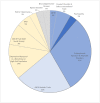Empathic Accuracy in Clinical Populations
- PMID: 32581862
- PMCID: PMC7283465
- DOI: 10.3389/fpsyt.2020.00457
Empathic Accuracy in Clinical Populations
Abstract
Empathy, broadly defined as the ability to understand the other and to share others' emotions, motivates prosocial behavior and underlies successful interpersonal relations. Dysfunctions in this ability may cause fundamental difficulties in social communication. Empathy has been measured in various ways, from self-report questionnaires to laboratory objective performance tests. Empathic accuracy (EA), i.e., the ability to accurately empathize, is measured using more complex and ecological paradigms, such as asking participants to infer filmed interactions, or having people narrate personal emotional stories then assessing the correspondence between the perceiver and the target of empathy as the criteria for empathic ability. This measure is particularly useful in the study of clinical populations, where deconstructing the multifaceted concept of empathy may contribute to a more complete understanding of specific clinical profiles. This paper presents a scoping review of the literature on EA in clinical populations, and on EA and clinical traits and states in nonclinical or high-risk populations. Following an exhaustive literature search, 34 studies were found eligible to be included in this review. The largest category was studies focused on EA in people with schizophrenia (31%; 11 papers), followed by studies focused on EA in autism spectrum disorders (ASD) and autistic traits in a nonclinical population (22%; 8 papers). Studies were also found on EA and depression tendencies, psychopathy, social anxiety, behavior disorders, and personality disorders, and a few other clinical conditions. The included studies varied on research aims, designs, sample sizes, and male:female ratios. The overall synthesized results suggest that EA is reduced in schizophrenia and ASD. In other clinical populations, the number of studies was very limited. We urge researchers to further examine EA in these less-studied populations. The review reveals a general underrepresentation of female participants in studies on EA in clinical populations. We suggest that future research address understudied clinical populations, such as those diagnosed with psychopathy. Subject, target, and situational variables should also be considered, with special attention to gender differences (and similarities), the association between EA abilities and adaptive functioning, and the study of individuals with clinical conditions as targets, not just observers, in EA tasks.
Keywords: anxiety; autism; behavior disorders; depression; empathic accuracy; personality disorders; psychopathy; schizophrenia.
Copyright © 2020 Rum and Perry.
Figures


Similar articles
-
Empathic accuracy in individuals with schizotypal personality traits.Psych J. 2024 Oct;13(5):813-823. doi: 10.1002/pchj.743. Epub 2024 Mar 26. Psych J. 2024. PMID: 38530878 Free PMC article.
-
Impaired cognitive empathy in criminal psychopathy: evidence from a laboratory measure of empathic accuracy.J Abnorm Psychol. 2013 Feb;122(1):156-166. doi: 10.1037/a0030261. Epub 2012 Oct 15. J Abnorm Psychol. 2013. PMID: 23067260
-
Empathic Accuracy and Cognitive and Affective Empathy in Young Adults With and Without Autism Spectrum Disorder.J Autism Dev Disord. 2022 May;52(5):2004-2018. doi: 10.1007/s10803-021-05093-7. Epub 2021 May 29. J Autism Dev Disord. 2022. PMID: 34052970 Free PMC article.
-
Empathic accuracy and relationship satisfaction: A meta-analytic review.J Fam Psychol. 2017 Sep;31(6):742-752. doi: 10.1037/fam0000320. Epub 2017 Apr 10. J Fam Psychol. 2017. PMID: 28394141 Review.
-
[Differential diagnosis of psychopathy and autism spectrum disorders in adults. Empathic deficit as a core symptom].Tijdschr Psychiatr. 2006;48(8):627-36. Tijdschr Psychiatr. 2006. PMID: 16958304 Review. Dutch.
Cited by
-
Feedback matters: EEG correlates of empathy involved in the naturalistic communication of emotions.Heliyon. 2024 Sep 27;10(19):e38574. doi: 10.1016/j.heliyon.2024.e38574. eCollection 2024 Oct 15. Heliyon. 2024. PMID: 39403498 Free PMC article.
-
Empathic accuracy in individuals with schizotypal personality traits.Psych J. 2024 Oct;13(5):813-823. doi: 10.1002/pchj.743. Epub 2024 Mar 26. Psych J. 2024. PMID: 38530878 Free PMC article.
-
Empathy and Mentalizing of Mental Health Nurses: A Cross-Sectional Correlational Study.Int J Ment Health Nurs. 2025 Feb;34(1):e70002. doi: 10.1111/inm.70002. Int J Ment Health Nurs. 2025. PMID: 39844727 Free PMC article.
-
Self-oriented affective empathy is associated with increased negative affect.Sci Rep. 2025 Jul 30;15(1):27767. doi: 10.1038/s41598-025-09860-9. Sci Rep. 2025. PMID: 40738905 Free PMC article.
-
Emotional Contagion and Emotional Mimicry in Individuals with Schizophrenia: A Systematic Review.J Clin Med. 2024 Sep 6;13(17):5296. doi: 10.3390/jcm13175296. J Clin Med. 2024. PMID: 39274509 Free PMC article. Review.
References
-
- Uzefovsky F, Knafo-Noam A. Empathy development throughout the life span. In: Social Cognition. New York: Routledge; (2016). p. 89–115.
-
- Walter H. Social cognitive neuroscience of empathy: concepts, circuits, and genes. Emotion Rev (2012) 4(1):9–17. 10.1177/1754073911421379 - DOI
Publication types
LinkOut - more resources
Full Text Sources

